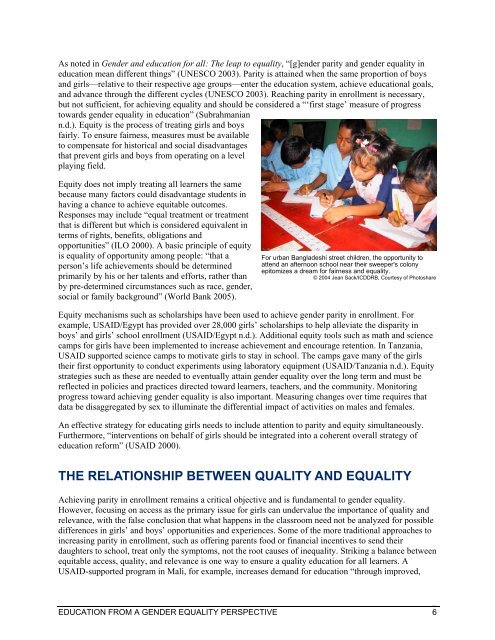Education from a Gender Equality Perspective - United Nations Girls ...
Education from a Gender Equality Perspective - United Nations Girls ...
Education from a Gender Equality Perspective - United Nations Girls ...
Create successful ePaper yourself
Turn your PDF publications into a flip-book with our unique Google optimized e-Paper software.
As noted in <strong>Gender</strong> and education for all: The leap to equality, “[g]ender parity and gender equality in<br />
education mean different things” (UNESCO 2003). Parity is attained when the same proportion of boys<br />
and girls—relative to their respective age groups—enter the education system, achieve educational goals,<br />
and advance through the different cycles (UNESCO 2003). Reaching parity in enrollment is necessary,<br />
but not sufficient, for achieving equality and should be considered a “‘first stage’ measure of progress<br />
towards gender equality in education” (Subrahmanian<br />
n.d.). Equity is the process of treating girls and boys<br />
fairly. To ensure fairness, measures must be available<br />
to compensate for historical and social disadvantages<br />
that prevent girls and boys <strong>from</strong> operating on a level<br />
playing field.<br />
Equity does not imply treating all learners the same<br />
because many factors could disadvantage students in<br />
having a chance to achieve equitable outcomes.<br />
Responses may include “equal treatment or treatment<br />
that is different but which is considered equivalent in<br />
terms of rights, benefits, obligations and<br />
opportunities” (ILO 2000). A basic principle of equity<br />
is equality of opportunity among people: “that a<br />
person’s life achievements should be determined<br />
primarily by his or her talents and efforts, rather than<br />
by pre-determined circumstances such as race, gender,<br />
social or family background” (World Bank 2005).<br />
For urban Bangladeshi street children, the opportunity to<br />
attend an afternoon school near their sweeper's colony<br />
epitomizes a dream for fairness and equality.<br />
© 2004 Jean Sack/ICDDRB, Courtesy of Photoshare<br />
Equity mechanisms such as scholarships have been used to achieve gender parity in enrollment. For<br />
example, USAID/Egypt has provided over 28,000 girls’ scholarships to help alleviate the disparity in<br />
boys’ and girls’ school enrollment (USAID/Egypt n.d.). Additional equity tools such as math and science<br />
camps for girls have been implemented to increase achievement and encourage retention. In Tanzania,<br />
USAID supported science camps to motivate girls to stay in school. The camps gave many of the girls<br />
their first opportunity to conduct experiments using laboratory equipment (USAID/Tanzania n.d.). Equity<br />
strategies such as these are needed to eventually attain gender equality over the long term and must be<br />
reflected in policies and practices directed toward learners, teachers, and the community. Monitoring<br />
progress toward achieving gender equality is also important. Measuring changes over time requires that<br />
data be disaggregated by sex to illuminate the differential impact of activities on males and females.<br />
An effective strategy for educating girls needs to include attention to parity and equity simultaneously.<br />
Furthermore, “interventions on behalf of girls should be integrated into a coherent overall strategy of<br />
education reform” (USAID 2000).<br />
THE RELATIONSHIP BETWEEN QUALITY AND EQUALITY<br />
Achieving parity in enrollment remains a critical objective and is fundamental to gender equality.<br />
However, focusing on access as the primary issue for girls can undervalue the importance of quality and<br />
relevance, with the false conclusion that what happens in the classroom need not be analyzed for possible<br />
differences in girls’ and boys’ opportunities and experiences. Some of the more traditional approaches to<br />
increasing parity in enrollment, such as offering parents food or financial incentives to send their<br />
daughters to school, treat only the symptoms, not the root causes of inequality. Striking a balance between<br />
equitable access, quality, and relevance is one way to ensure a quality education for all learners. A<br />
USAID-supported program in Mali, for example, increases demand for education “through improved,<br />
EDUCATION FROM A GENDER EQUALITY PERSPECTIVE 6

















